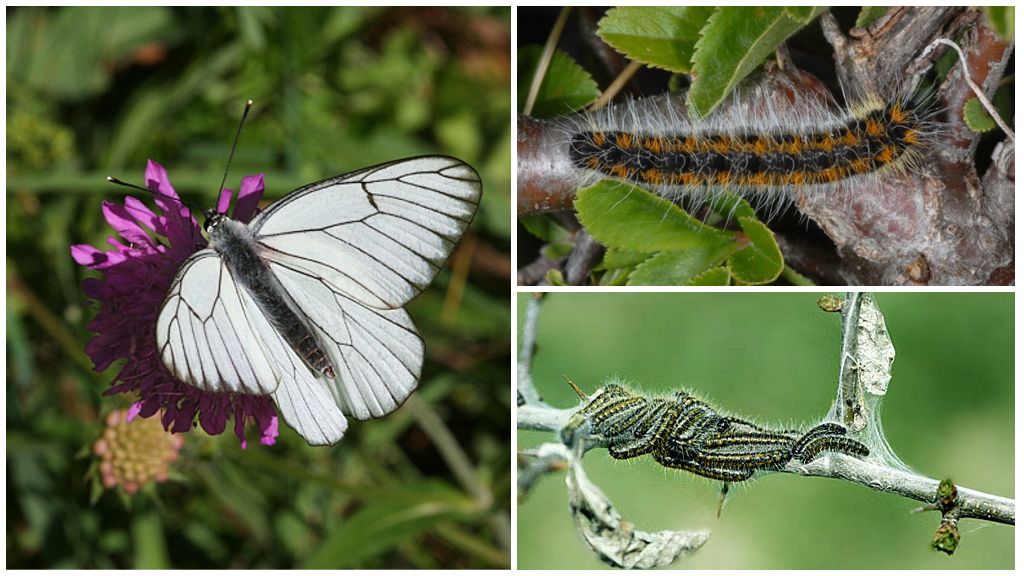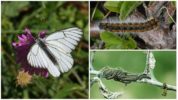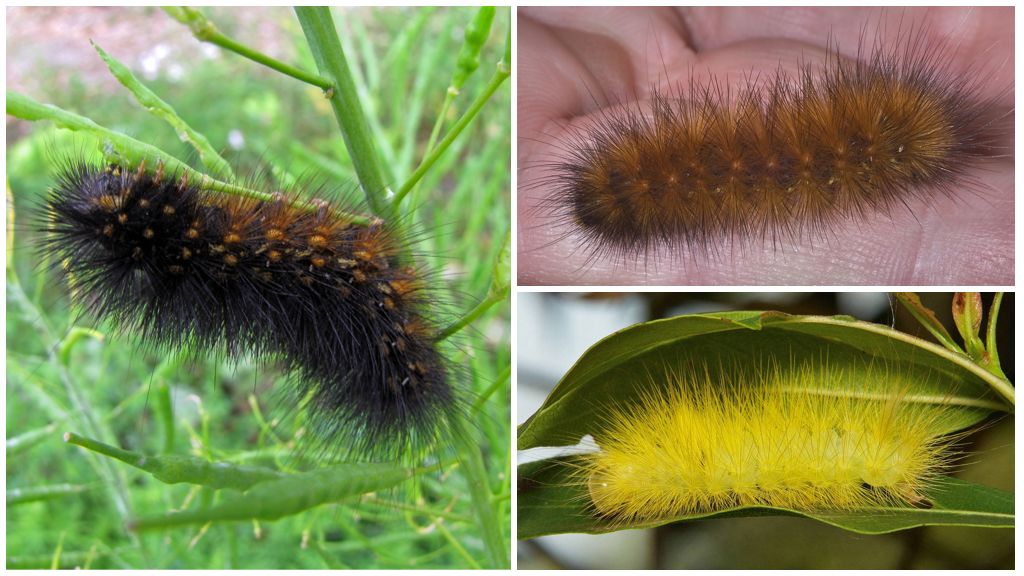- Caterpillar and Hawthorn Butterfly
- Track Control Methods
Among the many garden pests, butterflies occupy not the last place. These insects themselves are completely harmless and feed on nectar of flowers, acting as pollinators. But butterflies are not only beneficial. Their offspring would be able to starve their parents if the “cunning” butterflies did not feed on other plants, leaving some species of food for their caterpillars. Among pest butterflies, there is one shy - hawthorn, so named because one of the feed plants for its larvae is hawthorn. If the common hawthorn was limited only to this tree, it would not do much harm. But it does serious damage to gardens, parasitizing on fruit trees. For this reason, gardeners do not like a little white shy.
Butterfly Description
Butterfly hawthorn belongs to the family of whites and justifies the name of the family. She has completely white wings that cross dark veins. Sometimes the underside of the wings of a hawthorn may be reddish, yellow, or orange. But actually it is the color of pollen. Hawthorn is in very close contact with the stamens of flowers and pollen falls on the wings. The use of hawthorn as an insect pollinator is undeniable. The only question is: does this benefit outweigh the benefits caterpillars harm. In the photo of the hawthorn butterfly below, it can be seen that in the "pristine" form, these insects have only white and black colors.
The wingspan of an adult is 5-6.5 cm. The length of the front wing is up to 3.5 cm. This species is widespread throughout Eurasia and in Africa.
Track Description
The caterpillar of the hawthorn at an older age has a length of about 4.5 cm. The color of the caterpillar is gray on the sides with two longitudinal yellow stripes on the back. Between the yellow stripes runs black. As can be seen in the photo of the hawthorn caterpillar below, the larvae of this butterfly have protective bristles. So, besides the cuckoo, few of the birds dare to eat this pest.
On a note!
The main question that worries all gardeners is what the caterpillar of the hawthorn eats, because in fact the damage caused by the butterfly hawthorn does not come from an adult insect, but from its larvae.

What do they eat
These garden pests are not limited to the titular hawthorn. They also damage the main garden trees:
- plums
- apple trees;
- pears
- apricots.
Because of such addictions caterpillars seriously damage cultivated gardens. But not only garden trees suffer from them. Larvae like to enjoy other plants:
- mountain ash;
- thorn;
- average spirea;
- lingonberries;
- steppe almonds;
- rose hips;
- bird cherry.
The wide food range makes these butterflies very dangerous pests.
On a note!
When they feed, they braid the branches of the trees with silky thread and move inside the shelter. Larvae are very voracious. Under favorable conditions, the hawthorn caterpillar leaves only green veins from the green leaf.
Life cycle
Butterflies overwinter in the state of pupae and their life cycle begins after exiting the pupa in June. In the south, in warm weather, butterflies begin years in May.
Interesting!
The beginning of the summer of hawthorns served as a source of superstition about the "bloody rain."Indeed, the exit of an adult of this species from the state of the pupa is accompanied by the release of red liquid. This is not blood, but the physiological fluid of the insect.
After exiting suspended animation and mating, the female lays 60-100 eggs in batches of 12-14 pieces on "fodder" trees. After 2 weeks, larvae emerge from the eggs. Development will continue until frosts. The mass exit of larvae from eggs occurs in mid-July. Caterpillars grow slowly, feeding up to the colds. To frost, they grow to stage 3 and pupate in the winter.
The size of the pupa reaches 2 cm. Coloring can be gray in any shade. Black spots are required. This species is undemanding to pupation sites and pupae can be found everywhere, including fences and outbuildings. But they prefer to pupate caterpillars on the branches and bark of the same trees on which they fed during the growth process.
How long the hawthorn butterfly lives depends on what is meant by the terms. If you take into account the entire life cycle, then this insect lives a little more than a year. Imago - only 15 days.
Ways to fight

Few trees will be satisfied with silk-braided dying trees instead of a rich harvest. Therefore, gardeners are trying to get rid of this insect, despite the benefits brought by adults. Measures to control the hawthorn caterpillar are similar to the methods applied to other pests:
- attraction of natural enemies;
- destruction by chemicals;
- the use of manual collection of insects;
- the use of folk means of deterrence and destruction.
The choice of how to deal with the butterfly hawthorn depends on the contamination of the territory.
With a relatively low infection, birds are often attracted by arranging bird houses and birdhouses in the garden. Wintering tits pull out and peck cocoons of caterpillars. In spring, songbirds ruin the clutches of hawthorn, reducing the number of caterpillars by 70%.
With manual collection, the larvae are shaken off the trees onto the prepared material and then destroyed. The method is ineffective, since in this case only a small percentage of the caterpillars come across to gardeners.
With high infection in the spring, trees are treated with a solution of copper sulfate. Sprinkle the trees before budding. This method allows you to destroy all pests wintering under the bark.
Important!
Summer spraying with chemicals should be done when the larvae emerge from the eggs. Caterpillars stick together, massively attacking one plant and eating it to the state of the skeleton. It is not difficult to detect the accumulation of larvae at this moment. To protect the garden from the further spread of pests that emerged from the eggs of the caterpillars, they are destroyed by spraying with pesticides or manually.
Folk remedies for hawthorn butterflies are the same as for any other garden pests. To scare away the females from the garden, infusions of sharply smelling plants are used: wormwood, tobacco, garlic.
Prevention
To reduce the number of pests after falling leaves and before the new buds open, it is necessary to collect all the fallen leaves and burn them. Collect and burn cocoons attached to branches. On bare branches without foliage, these cocoons are clearly visible and it will not be difficult to find them.





